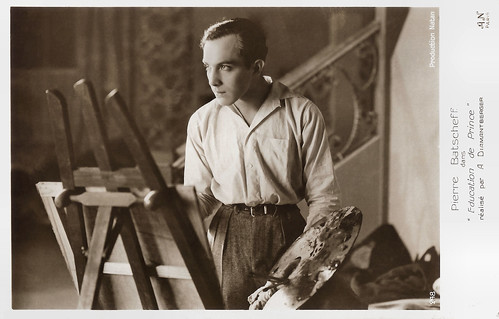
French postcard by A.N., Paris, no. 248. Photo: Production Natan. Pierre Batcheff in Education de prince (Henri Diamant-Berger, 1927).
Pierre Batcheff (1901-1932) was a French film actor who became famous for his part in the surrealist film Un chien andalou/An Andalusian Dog (Luis Bunuel, Salvador Dali, 1929).

French postcard by A.N., Paris, no. 250. Photo: Production Natan. Armand Bernard and Jules Moy in Rue de la paix (Henri Diamant-Berger, 1927).
Armand Bernard (1893-1968) was a French actor, composer, and bandleader. With his heavy diction and his air of dignity, he brought a comical note to many French comedies.

French postcard by A.N., Paris, no. 252. Photo: Production Natan.
Léon Mathot was a French actor and director, born in 1886 in Roubaix and died in 1968 in Paris. Mathot became well-known for his role of Edmond Dantès in the French serial Le Comte de Monte Christo (1918), directed by Henri Pouctal. He is also known for his role in Coeur fidèle (1923) by Jean Epstein.

French postcard by A.N., Paris, no. 257. Photo: Production Natan.
Suzy Pierson (1902-1994) was a French film actress, known for such films as Six et demi onze (Jean Epstein, 1927), Rue de la paix (Henri Diamant-Berger, 1927), and the early sound film Quand nous étions deux (Léonce Perret, 1930). Over the 1930s Pierson's got smaller, and in the 1940s she only played in two films before calling it a day. All in all, she played in 20 silent and 14 sound films.
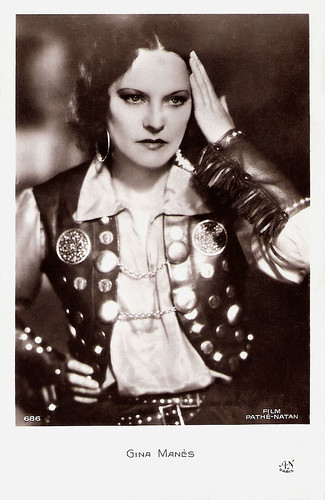
French postcard by A.N., Paris, no. 686. Photo: Pathé-Natan.
French actress Gina Manès (1893-1989) starred in some 90 films between 1916 and 1966. She is best known for the silent classics Coeur fidèle (1923) and Thérèse Raquin (1928).
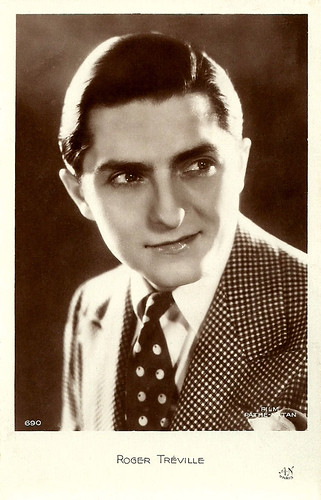
French postcard by A.N., Paris, no. 690. Photo: Pathé-Natan.
French singer and actor Roger Tréville (1902-2005) was a popular star of the early 1930s. Between 1908 and 1980 he appeared in more than fifty films and TV series in France but also in Great Britain, Germany, Italy, and the USA.
From projectionist and chemist to cinematographer and producer
Bernard Natan was born Natan Tannenzaft (possibly Tanenzapf) to Jewish parents in Iaşi, Romania in 1886.
In the early 1900s, he moved to France. He worked in mainstream cinema from his youngest days, working his way up from projectionist and chemist to cinematographer and producer.
In 1909 he married and subsequently had two children. In 1911, Natan and colleagues were convicted of making erotic films, he was jailed for a short time and fined 1,000 francs. Despite being a Romanian, he volunteered to fight for France in World War I. Due to his exceptional record fighting in World War I, his earlier conviction was removed from his record.
In 1921 he became a French citizen, and at some point, he changed his name to Bernard Natan. His younger brother Emile Natan also moved to France and became a film producer. Natan was a publicity stringer for Paramount Pictures during the early 1920s. Natan became the owner of Rapid Film, which had exclusive rights to film the 1924 Paris Olympics, and ran studios where silent-era luminaries such as Marcel l’Herbier made groundbreaking films.
In 1924 Natan became a member of the executive committee of the Cinematographic Employers' Federation. By 1926, his film laboratory was highly regarded, he had established a marketing firm, and he built two sound stages.
Natan was also a film producer, helping finance and produce films at other studios. By 1929, Natan's Rapid Film had become a major film producer and distributor.
In late February 1929, Bernard Natan acquired the production and exhibition businesses of Pathé, then the largest French film company. He agreed to merge his own studio, Rapid Film (then worth 25 million francs), with Pathé in exchange for 50 million francs in shares. The remaining shares were purchased with funding from a consortium of banks, bonds (to be paid with income from Pathé), and a 10 percent ownership in Pathé by the banks. After the merger, Natan renamed the company Pathé-Natan (sometimes also credited as Pathé-Cinéma).

French postcard by Rasiogravure A. Breger Frères, Paris for Victor-Hugo Théâtre Pathé-Natan. Photo: Raimu in Charlemagne (Pierre Colombier, 1933).
Beloved, down-to-earth character actor Raimu (1883-1946) was one of the major stars of French cinema in the 1930s. He started his career as a comedian at the Folies Bergère and other major Paris venues, and in 1929 he had his breakthrough as a serious actor with his part as César in the Marseille trilogy Marius-Fanny-César by Marcel Pagnol.
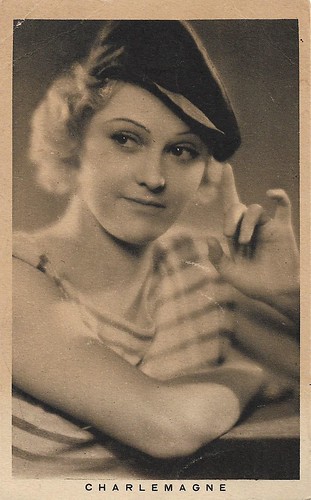
French postcard by Rasiogravure A. Breger Frères, Paris for Victor-Hugo Théâtre Pathé-Natan. Photo: Marie Glory in Charlemagne (Pierre Colombier, 1933). Publicity for the release of the film at the Pathé Natan cinema in Lyon as of 22 December 1933.
French actress Marie Glory (1905-2009) was a beautiful ingénue of the French cinema in the 1920s and 1930s. In later years, she mainly played minor roles in Italian films.
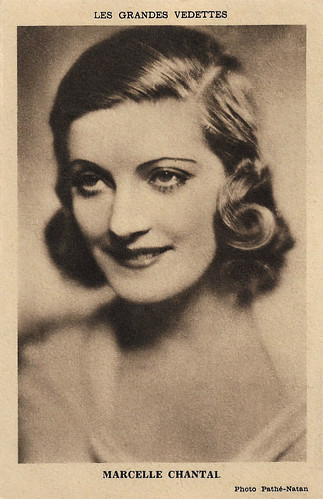
French postcard in the Les grandes vedettes series by Radiogravure A. Breger Frères, Paris, offered by L'Industrie Boutonnière, St. Maur-des-Fossés. Photo: Pathé-Natan.
Elegant French stage and film actress Marcelle Chantal (1901–1960) appeared in leading roles in such films as Maurice Tourneur's In the Name of the Law (1932) and La Tragédie impériale/Rasputin (Marcel L'Herbier, 1938) featuring Harry Baur.

French postcard. Photo Pathé-Natan. André Luguet and Gaby Morlay in Il était une fois/Once Upon a Time (Léonce Perret, 1933). Gaby Morlay, Georges Mauloy, André Dubosc, Jean Max and Jean Bara reprised the roles they had created at the Théâtre des Ambassadeurs in Paris from 12-2-1932.
André Luguet (1892-1979) was a French stage and film actor. He appeared in over 120 films between 1910 and 1970, both in France and Hollywood.
Gaby Morlay (1893-1964) was a French actress with a long-standing career, playing in over 100 films. She compensated for her small size (1.53 m.) with passion and enthusiasm.
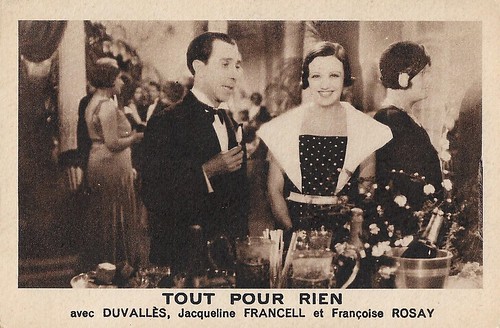
French postcard. Publicity by the Cinema Victor-Hugo (Pathé-Natan), showing 13-26 October [1933] the film Tout pour rien/All for nothing (René Pujol, 1933), starring Frédéric Duvallès and Jacqueline Francell.
The plot deals with an honest but naive young man (Duvallès), who is manipulated by a gang of crooks (led by Pierre Alcover) who use him as a cover for their misdeeds. They hire him as the manager of a big dime store called "Tout pour rien" (all for nothing) with a fantastic wage until the police start to chase him. His honesty will be rewarded though and he will find the way to the heart of his beloved (Francell), despite the opposition of her proud mother (Françoise Rosay).
The address on the back of the card given for the cinema, Avenue Victor Hugo, corner rue la Pompe, is a bit odd, as the former cinema was on the other side of the street, at 65, rue St. Didier. The Modernist style cinema, commissioned by Pathé-Natan, opened in 1931. The exterior was designed by the architects Jean Charavel et Marcel Melendès, the auditorium by Eugène Bruyneel, the leading architect at Pathé-Cinéma. It was a typical second-run cinema, which showed films after they had been shown at the first-night cinemas on the Grands Boulevards or the Champs-Elysées. In 1970 it was completely remodeled and in 1986 it closed down. The building is still there. See salles-cinema.com/anciens-cinemas/pathe-victor-hugo.
Antisemitic attacks and veiled homophobic allusions
In 1929, Pathé was already in substantial financial trouble when Natan took control. Studio founder Charles Pathé had been selling assets for several years to boost investor value and keep the studio's cash flow healthy. The company's founder had even sold Pathé's name and "rooster" trademark to other companies in return for a mere 2 percent of revenues generated by them. Natan had the bad luck to take charge of the studio just as the Great Depression convulsed the French economy.
Natan attempted to steady Pathé's finances and implement modern film industry practices at the studio. Natan acquired another film studio, Société des Cinéromans, from Arthur Bernède and Gaston Leroux, which enabled Pathé to expand into projector and electronics manufacturing. He also bought the Fornier chain of motion picture theaters and rapidly expanded the chain's nationwide presence. The French press, however, attacked Natan mercilessly for his stewardship of Pathé. Many of these attacks were antisemitic and contained veiled homophobic allusions to Natan's supposed sexuality.
His mainstream films attracted attention, often for their political content. He produced some of the masterpieces of French 1930s cinema, including Les Croix de bois/Wooden Crosses (Raymond Bernard, 1932). Pamela Hutchinson in The Guardian: "a powerful war film made all the stronger by the fact that it was created by and starred so many veterans of the 1914-18 conflict, including Natan himself."
His film, Le dernier milliardaire/The Last Billionaire (René Clair, 1934), starring Max Dearly, ridiculed German Nazi leader Adolf Hitler and caused rioting by French Nazi sympathizers.
Pathé-Natan did well under Natan's guidance. Between 1930 and 1935, despite the world economic crisis, the company made 100 million francs in profits and produced and released more than 60 feature films (just as many films as major American studios produced at the time). He resumed production of the newsreel Pathé News, which had not been produced since 1927.
Natan also invested heavily in research and development to expand Pathé's film business. In 1929, he pushed Pathé into the sound film. In September, the studio produced its first sound feature film and its first sound newsreel a month later. Natan also launched two new cinema-related magazines, Pathé-Revue and Actualités Féminines, to help market Pathé's films and build consumer demand for cinema. Under Natan, Pathé also funded the research of Henri Chrétien, who developed the anamorphic lens, a technology which later led to the creation of CinemaScope and other widescreen film formats common today.
Natan expanded Pathé's business interests into communications industries other than film. In November 1929, Natan established France's first television company, Télévision-Baird-Natan. A year later, he purchased a radio station in Paris and formed a holding company (Radio-Natan-Vitus) to run what would become a burgeoning radio empire.
In 1935, Pathé went bankrupt. In order to finance the company's continued expansion, Pathé's board of directors (which still included Charles Pathé) voted in 1930 to issue shares worth 105 million francs. But with the depression deepening, only 50 percent of the shares were purchased. One of the investor banks collapsed due to financial difficulties unrelated to Pathé's problems, and Pathé was forced to follow through with the purchase of several cinema chains it no longer could afford to buy. Although the company continued to make a profit for a time, it soon began to lose more money than it could bring in.
The collapse of Pathé led French authorities to indict Bernard Natan on charges of fraud. Natan was accused of financing the purchase of the company without any collateral, of bilking investors by establishing fictitious shell corporations, and of negligent financial mismanagement. Natan was even accused of hiding his Romanian and Jewish heritage by changing his name. Natan was indicted and imprisoned in 1939.
This meant he was in prison when France fell to the Nazis, while most other major Jewish filmmakers were able to flee the country or go into hiding. A second indictment was brought in 1941, and he was convicted shortly thereafter. His French citizenship was taken away, which required special legal maneuvers by the state since he had been naturalised as a result of his WWI military service and there were no existing legal means to render him stateless.
After Natan's release from prison, the French government handed him over to the occupying German authorities. Natan was sent to the Auschwitz concentration camp in Poland on 25 September 1942, where it is believed he died in 1943. His wife received a letter from him in early 1943, this was their last contact.
Pamela Hutchinson in The Guardian: "Natan’s crime appears to have been to be successful, and Jewish, in an era of antisemitism and fear."
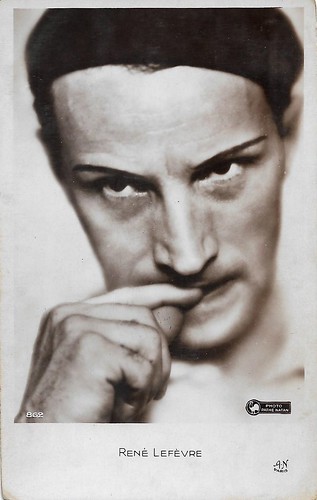
French postcard by A.N., Paris, no. 862. Photo: Pathé-Natan.
French actor René Lefèvre (1898-1991) became a star as the working-class hero of the classics Le Million (1931) and Le Crime de Monsieur Lange (1936). He was a ‘quadruple threat’ man: next to as an actor he was also active as a writer, producer, and director.

French postcard by Erres, no. 6. Photo: Pathé-Nathan.
French actress Rosine Deréan (1910-2001) was a popular star of the French cinema of the 1930s. Her best-known films are the melodrama Les deux orphelines (1933) and the romantic drama Lac aux dames (1934). She was married to Claude Dauphin and was a member of the French Resistance during the Second World War.

French postcard by PC, Paris, no. 11. Photo: Pathé-Natan.
During the 1930s and 1940s, Jacqueline Francell (1908-1962) was a popular star of the French operetta. She also appeared in operas at the Théâtre des Champs-Élysées, and in 1930, she created the role of Princess Blanche-Aline in Les Aventures du roi Pausole by Arthur Honegger. She also starred in a dozen films between 1931 and 1944.

French postcard by P.C., Paris, no. 47. Photo: Pathé-Natan.
French actress Renée Saint-Cyr (1907-2004) starred as the classy lady and keeper of good taste in the French cinema of the 1930s and 1940s. She continued to perform in film in the following decades as well.
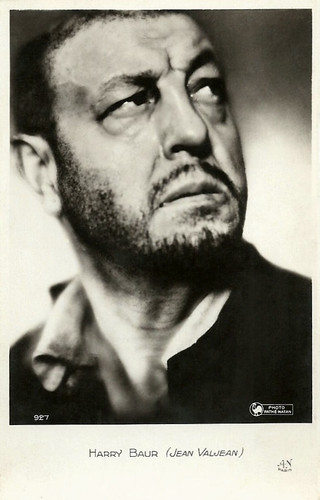
French postcard by A.N., Paris, no. 927. Photo Pathé-Natan.
Harry Baur (1880-1943) was a famous French film and stage actor. Directed by directors as wide-ranging as Julien Duvivier, Raymond Bernard, Abel Gance, Marcel L'Herbier, Pierre Chenal, Robert Siodmak and Maurice Tourneur, he switched just as easily from père Lepic of Poil de carotte, to commissaire Maigret, Jean Valjean from Les Misérables, judge Porphyre from Crime et chatiment, Hérode, Tarass Boulba, Beethoven, captain Mollenard, czar Paul I, Rasputin, and Volpone.
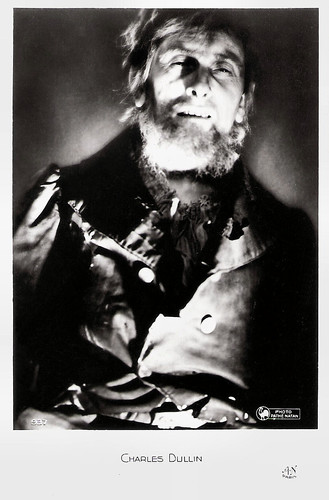
French postcard by A.N., Paris, no. 937. Photo: Pathé-Natan. Charles Dullin as the evil Thénardier in the film Les Misérables (Raymond Bernard, 1934), starring Harry Baur as Jean Valjean, and adapted from the often filmed novel by Victor Hugo.
Charles Dullin (1885-1949) was a French actor, theatre manager, and director.

French postcard by A.N., Paris, no. 970. Photo: Pathé-Natan.
Max Dearly (1874-1943) was a French actor, famous for his parts in 1930s French sound film but also for his previous career in Parisian vaudeville.
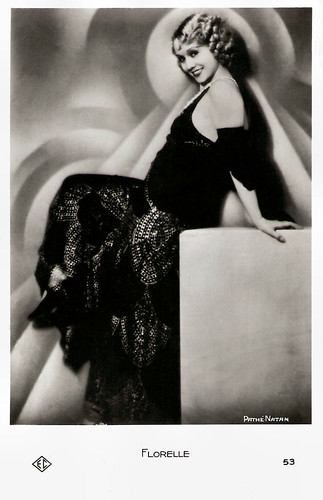
French postcard by EC (Editions Chantal), no. 53. Photo: Pathé-Natan.
French music hall star Florelle (1898-1974) was one of the queens of Paris. The petite blonde appeared in 54 films between 1912 and 1956, and also toured around the world. Her most beautiful role was that of Fantine in the classic version of Les Miserables (1934).
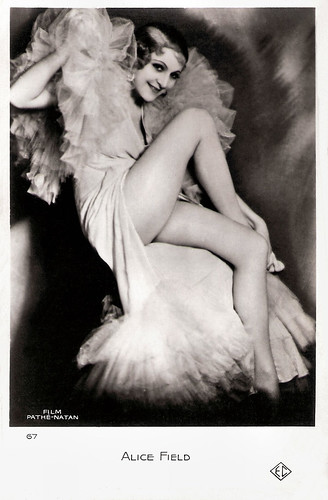
French postcard by EC, no. 67. Photo: Pathé-Natan.
French actress Alice Field (1903-1969) started out in the silent film era. Her career got on steam in the 1930s when she starred in several French-language versions of German film classics.

French postcard by EDUG, no. 1087. Photo: Pathé-Natan.
French actor Pierre Blanchar (1892-1963) was one of France's most popular show business personalities. He made many memorable stage appearances and appeared in 54 films. He often played characters who were complex and tortured. During the war, he also worked as a film director.
Sources: Pamela Hutchinson (The Guardian), Wikipedia, and IMDb.
No comments:
Post a Comment